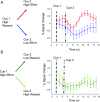Corticoinsular circuits encode subjective value expectation and violation for effortful goal-directed behavior
- PMID: 29760060
- PMCID: PMC5984520
- DOI: 10.1073/pnas.1800444115
Corticoinsular circuits encode subjective value expectation and violation for effortful goal-directed behavior
Abstract
We are presented with choices each day about how to invest our effort to achieve our goals. Critically, these decisions must frequently be made under conditions of incomplete information, where either the effort required or possible reward to be gained is uncertain. Such choices therefore require the development of potential value estimates to guide effortful goal-directed behavior. To date, however, the neural mechanisms for this expectation process are unknown. Here, we used computational fMRI during an effort-based decision-making task where trial-wise information about effort costs and reward magnitudes was presented separately over time, thereby allowing us to model distinct effort/reward computations as choice-relevant information unfolded. We found that ventromedial prefrontal cortex (vmPFC) encoded expected subjective value. Further, activity in dorsal anterior cingulate (dACC) and anterior insula (aI) reflected both effort discounting as well as a subjective value prediction error signal derived from trial history. While prior studies have identified these regions as being involved in effort-based decision making, these data demonstrate their specific role in the formation and maintenance of subjective value estimates as relevant information becomes available.
Keywords: anterior insula; dorsal anterior cingulate; effort-based decision making; prediction error; ventromedial prefrontal cortex.
Copyright © 2018 the Author(s). Published by PNAS.
Conflict of interest statement
Conflict of interest statement: In the past 3 y, M.T.T. has served as a paid consultant to Boston Consulting Group, NeuroCog Trials, Avanir Pharmaceuticals, and Blackthorn Therapeutics. No funding from these entities was used to support the current work.
Figures





References
-
- Massar SA, Libedinsky C, Weiyan C, Huettel SA, Chee MW. Separate and overlapping brain areas encode subjective value during delay and effort discounting. Neuroimage. 2015;120:104–113. - PubMed
Publication types
MeSH terms
Grants and funding
LinkOut - more resources
Full Text Sources
Other Literature Sources

